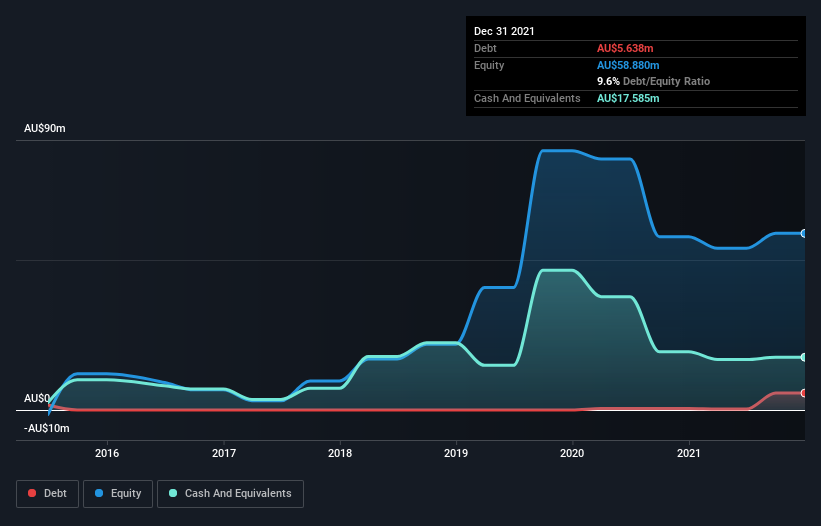Health Check: How Prudently Does LiveTiles (ASX:LVT) Use Debt?
Warren Buffett famously said, 'Volatility is far from synonymous with risk.' So it seems the smart money knows that debt - which is usually involved in bankruptcies - is a very important factor, when you assess how risky a company is. As with many other companies LiveTiles Limited (ASX:LVT) makes use of debt. But is this debt a concern to shareholders?
Why Does Debt Bring Risk?
Debt and other liabilities become risky for a business when it cannot easily fulfill those obligations, either with free cash flow or by raising capital at an attractive price. In the worst case scenario, a company can go bankrupt if it cannot pay its creditors. However, a more frequent (but still costly) occurrence is where a company must issue shares at bargain-basement prices, permanently diluting shareholders, just to shore up its balance sheet. Of course, plenty of companies use debt to fund growth, without any negative consequences. When we think about a company's use of debt, we first look at cash and debt together.
See our latest analysis for LiveTiles
What Is LiveTiles's Net Debt?
As you can see below, at the end of December 2021, LiveTiles had AU$5.64m of debt, up from AU$463.9k a year ago. Click the image for more detail. However, its balance sheet shows it holds AU$17.6m in cash, so it actually has AU$11.9m net cash.

How Strong Is LiveTiles' Balance Sheet?
We can see from the most recent balance sheet that LiveTiles had liabilities of AU$33.5m falling due within a year, and liabilities of AU$22.0m due beyond that. Offsetting these obligations, it had cash of AU$17.6m as well as receivables valued at AU$8.45m due within 12 months. So it has liabilities totalling AU$29.5m more than its cash and near-term receivables, combined.
This deficit isn't so bad because LiveTiles is worth AU$114.8m, and thus could probably raise enough capital to shore up its balance sheet, if the need arose. But it's clear that we should definitely closely examine whether it can manage its debt without dilution. Despite its noteworthy liabilities, LiveTiles boasts net cash, so it's fair to say it does not have a heavy debt load! When analysing debt levels, the balance sheet is the obvious place to start. But ultimately the future profitability of the business will decide if LiveTiles can strengthen its balance sheet over time. So if you want to see what the professionals think, you might find this free report on analyst profit forecasts to be interesting.
In the last year LiveTiles wasn't profitable at an EBIT level, but managed to grow its revenue by 28%, to AU$51m. With any luck the company will be able to grow its way to profitability.
So How Risky Is LiveTiles?
By their very nature companies that are losing money are more risky than those with a long history of profitability. And the fact is that over the last twelve months LiveTiles lost money at the earnings before interest and tax (EBIT) line. Indeed, in that time it burnt through AU$4.4m of cash and made a loss of AU$7.3m. But at least it has AU$11.9m on the balance sheet to spend on growth, near-term. With very solid revenue growth in the last year, LiveTiles may be on a path to profitability. By investing before those profits, shareholders take on more risk in the hope of bigger rewards. There's no doubt that we learn most about debt from the balance sheet. But ultimately, every company can contain risks that exist outside of the balance sheet. For example, we've discovered 4 warning signs for LiveTiles that you should be aware of before investing here.
Of course, if you're the type of investor who prefers buying stocks without the burden of debt, then don't hesitate to discover our exclusive list of net cash growth stocks, today.
The New Payments ETF Is Live on NASDAQ:
Money is moving to real-time rails, and a newly listed ETF now gives investors direct exposure. Fast settlement. Institutional custody. Simple access.
Explore how this launch could reshape portfolios
Sponsored ContentNew: AI Stock Screener & Alerts
Our new AI Stock Screener scans the market every day to uncover opportunities.
• Dividend Powerhouses (3%+ Yield)
• Undervalued Small Caps with Insider Buying
• High growth Tech and AI Companies
Or build your own from over 50 metrics.
Have feedback on this article? Concerned about the content? Get in touch with us directly. Alternatively, email editorial-team (at) simplywallst.com.
This article by Simply Wall St is general in nature. We provide commentary based on historical data and analyst forecasts only using an unbiased methodology and our articles are not intended to be financial advice. It does not constitute a recommendation to buy or sell any stock, and does not take account of your objectives, or your financial situation. We aim to bring you long-term focused analysis driven by fundamental data. Note that our analysis may not factor in the latest price-sensitive company announcements or qualitative material. Simply Wall St has no position in any stocks mentioned.
About ASX:LVT
LiveTiles
LiveTiles Limited, a workplace technology company, engages in the provision of software as a service solution in Australia, North America, Europe, and the Asia Pacific.
Low and slightly overvalued.
Market Insights
Weekly Picks

THE KINGDOM OF BROWN GOODS: WHY MGPI IS BEING CRUSHED BY INVENTORY & PRIMED FOR RESURRECTION


Why Vertical Aerospace (NYSE: EVTL) is Worth Possibly Over 13x its Current Price


The Quiet Giant That Became AI’s Power Grid
Recently Updated Narratives

Deep Value Multi Bagger Opportunity


A case for CA$31.80 (undiluted), aka 8,616% upside from CA$0.37 (an 86 bagger!).


Unicycive Therapeutics (Nasdaq: UNCY) – Preparing for a Second Shot at Bringing a New Kidney Treatment to Market (TEST)
Popular Narratives


MicroVision will explode future revenue by 380.37% with a vision towards success


NVDA: Expanding AI Demand Will Drive Major Data Center Investments Through 2026


Crazy Undervalued 42 Baggers Silver Play (Active & Running Mine)
Trending Discussion



